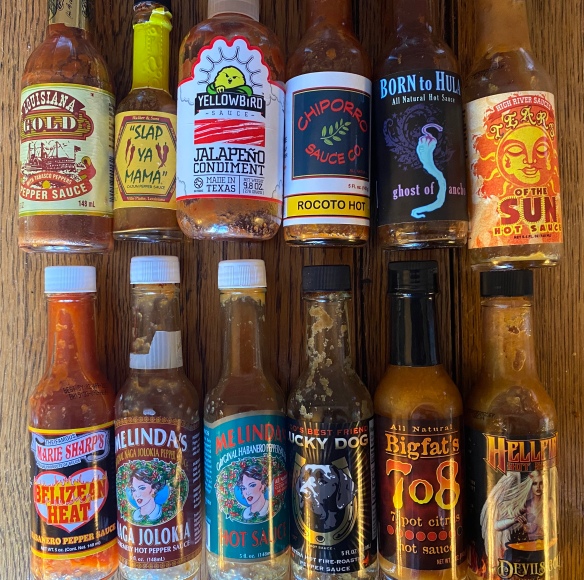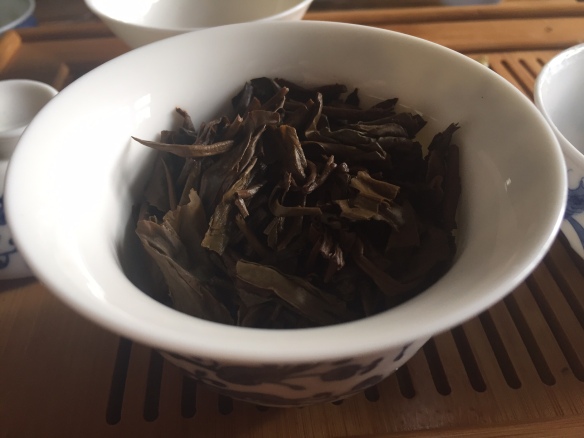After a recent professional pivot, I am now literally an academic specialist in the philosophy of games. (Here’s my new book on games as an art form.) The main change in my life is that everybody now asks me for board game recommendations at Christmas. Or maybe it’s because I have so many damn boardgames that I actually have to keep a spreadsheet to remember where they all are.
Here’s my recommendations for people putting their first or second feet into the modern boardgames pond, tilted towards the accessible, the crucial, and the still in-print or easy to find used. Sadly, a majority of my favorite games are currently out of print and painfully expensive. Boo hoo. (If you want to see what I think about hundreds and hundreds of game, I have an account at Boardgamegeek where I’ve been reviewing games for like a decade.)
Here’s the difficulty scale:
E = Easy (Simple family games not much harder than Monopoly. Often teachable in a couple of minutes)
M = Medium (Your average modern Euro boardgames. Some mild effort to learn, but not too intimidating for the average moderately intelligent adult. Think Settlers of Cataan)
H = Hard (Hobbyist territory. Long rule-books, complex and emergent play)
UH = Ultra-hard (Mega-geek territory. May involve 20 page rulebooks, war-games with thousands of exceptions, actual spreadsheets)
A brief word on pricing: some people here may not have dipped their toes into modern boardgames before, and might be shocked at the prices, especially for some of the more esoteric games. Fifty bucks for a boardgame? But let me suggest the following calculation: if you play such a boardgames only once, and 5 people have two hours of fun together, that’s already cheaper than going out to a movie together, or even a modest dinner out together. If you play it ten times, then you’re already into one of the great entertainment bargains.
Party games and family games
Spyfall (E): Hysterical ultra-simple game of bullshit and bullshit detection, that is possibly the hardest I’ve ever laughed in a game. All but one players are on a team together. You are secretly assigned a single location together: like, you’re all at the Opera together, or in a Submarine, or at an Amusement Park. One of you is the SPY, who is the only person that doesn’t know the collective location. The assignments are all random and secret. Only nobody else knows who the spy is, and the spy doesn’t know the location. The spy wins if they figure out the location. Everybody else wins together if they figure out who the spy. And then you just talk. What follows is a delicate dance of subtle questioning, concealment, bullshittery, and passing hidden information in plain sight, and it has never failed to reduce a group of grown adults into hysterical fits of laughter.
(Or, if you want a more structured experience for your bullshitting, try Coup (E): a slick, fast, sharp little bluffing game where everybody has two secret roles with special powers, but you can try to claim any kind of special power, unless somebody calls bullshit on you.)
Codenames (E): Team party game, where one big group takes on another big group. Every team elects a Spymaster. Together, everybody faces this random 5×5 grid of words:
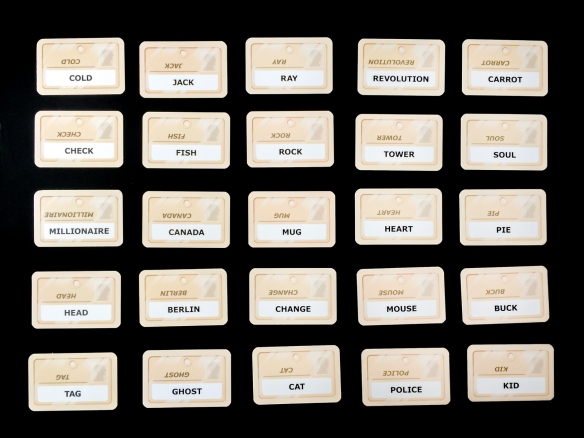
The Spymaster has to try to get their team to touch specific words, but they can only communicate to their team using a single word and a number. For example, if I’m the Spymaster, and I’m trying to get you to touch MUG, PIE, and FISH, I might say: “DINNER: 3”. That’s all I’m allowed to say. And then my team has to loudly and miserably argue out all the possibilities of what I meant and try to figure out the right ones to pick. And they’ll probably pick something stupid like PIE, FISH, and JACK, because they were thinking of “Monterey Jack”, and they all somehow were thinking MUG meant like a robbery, and basically they’re all stupid. Except it’s me that’s stupid. Because I didn’t notice that possible interpretation ahead of time, and I didn’t plan for it. This is a game about the difficulty of communication, and how much we don’t understand each other, and how wildly easy it is to misunderstand another person’s intention. It is also just this a perfectly satisfying thing to try to do with your mind. It’s like… a game of data compression, where you’re trying to squeeze extra information into a little package, through the magic of patterns and implication.
Hamsterolle (E): Kind of like Jenga, but played inside a round wheel that keeps rolling. And as a partnership game. Subtle, strategic, gives rise to bounteous amounts of shit-talking.
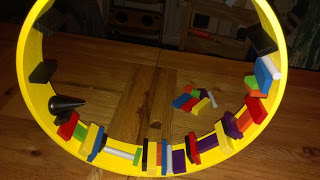
Bandu (E): Kind of like Jenga, but where you each have your own stack, and people force each other to add increasingly oddly shaped objects. Hysterical, fascinatingly strategic, a hell of a lot of game for, like, three rules.
Blokus (E): Four player attack Tetris, where you try to carve off space for yourself and slip and slide around other people’s shapes to sneak into their territory. Everybody likes this.
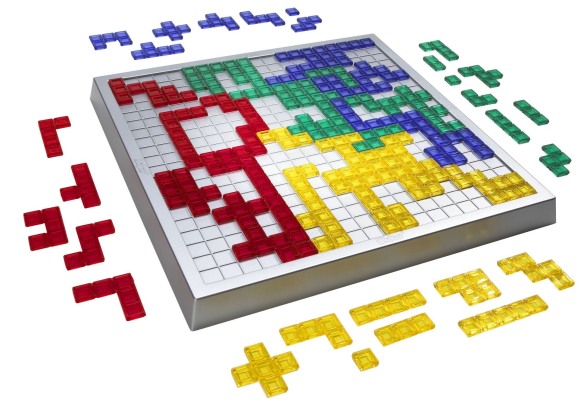
Wits and Wagers (E): Genius trivia game design. Somebody out there realized that Trivial Pursuit was the worst possible game, and took it on themselves to actually make an interesting trivia game that was interesting even for people that don’t know any trivia. Questions are bizarre, super-hard, and quantitative. “How many gallons flows through the Amazon on the average year?” “What year was the NAACP founded?” Stage 1: Try to guesstimate the closest answer. Stage 2: Reveal all the guesses, don’t read the answer. Instead, arrange the guesses in numerical on an odds board. The middle answer gets 1:1 odds, the next two out get 2:1 odds, etc. etc. Then you bet money on which answer will turn out to be right.
There are loads of ways to strategize. You can actually try to get the right answer. You can bet based on who you think might actually know the answer. You can put out a spread of bets based on the odds and point spread. You can even give lie answers to screw with other people. Like when the question was literally, “What is Immanuel Kant’s birthday?” and I wrote “1673” and everybody bet on my answer because I’m the philosopher and they trusted me and then I was like HAHAHAHAHAHA.
Dixit (E): First, the game has the single greatest deck of cards in all game-dom. The cards look like this:

I would buy this game just for the cards to do other things with them. I once drunkenly made up the game of playing Texas Hold’em with these cards, and the winner had to use their two hole cards and the river to tell the best story.
Anyway: the real Dixit game is fabulous and simple. It’s a kid’s game. Basically it’s Apples to Apples or Cards Against Humanity’s basic mechanic, only not stupid and boring. Everybody has a hand of five of these magical dreamy image-cards. When it’s your turn, you pick one image-card, say an ambiguous line of story that’s vaguely related to it, and put your card face-down. Everybody else tries to match your fragment of story with an image-card from their own hand. We mix and reveal all the image-cards, and everybody tries to successfully pick which one was the real, original card. Lovely.
(Also, if you want an adult version of this game, try Mysterium (M), which uses a similar deck of image-cards to play something like Clue. Most of the players are detectives puzzling out a murder. One of you is the ghost of the murdered and has to communicate clues to all the other players only by making ghostly inchoate noises and picking image-cards from the deck. You’re a ghost sending useful dreams.)
Catacombs (M): This has almost enough rules that it should be in the next category, but it’s just so gleefully stupid. Catacombs is a dungeon crawl. You play your stock heroes – fighter thief, mage. There’s a dungeon master. Except, instead of rolling die to attack, all the heroes and all the monsters are different discs. And you flick to attack. And there are obstacles. And archers get little extra arrow discs, and the wizard’s fireball spell lets you pull out this MASSIVE HUGE DISC and just SHOVE IT, and you can level up and get better discs and more discs, and it’s so fucking stupid, and I think one time I laughed so hard playing this game that I strained an ab.
Real board games, multiplayer
Hansa Teutonica (M): If I had to give one exemplar of clean, wonderful, well-designed, slick modern German-style board gaming, it’s gotta be Hansa Teutonica. It’s got a lot of the standard features of modern Eurogaming – different special powers, opportunities for picking up a steady stream of little points versus pulling off an on-board epic big final pattern for one massive point-splosion at the end. But instead of being locked into a pattern, or solitarily calculating out your own little private economic machine, Hansa puts most of the special powers on the board, where you have to spend your moves competing for them. Which means that you constantly have to be shifting your plans based on what’s being overvalued and undervalued, and play fluidly, and dance around the other player’s intention. The game builds in this wonderful, dynamic, ever-shifting way. Not a moment of boredom. If you’ve been playing Settlers of Cataan and thinking you’re having “fun”, please try this instead.
(Other very fine modern slick Eurogames with various kinds of special powers and resources include Lancaster (M), The Voyages of Marco Polo (M), Dungeon Lords (M), and like a billion more.)
Modern Art (M): OH MY GOD IT’S FINALLY BACK IN PRINT. From Reiner Knizia, the master, the Mozart of German game design, the never-ending fount of elegant game design masterpieces, the master of auctions. Modern Art is perhaps the loveliest sharp-edged little horror in his massive catalogue of auction games. The theme is marvelously cynical: you’re all modern art dealers trading paintings by five hot contemporary artists. In each round, you auction art to one another other. And then at the end of the round, the art-hungry public buys that same art from you dealers, hopefully for much more money. The trick: what the public pays is based entirely on how many times you dealers traded that particular artist. And that value is cumulative over the rounds, making the game into this long-term strategic market manipulation. You might think, at first, that the game was all short-term math. This is false. I kill at this game, and I never do any math. The game is all about long-term market manipulation, playing the psychology of the other players, setting off market-rushes, predicting the flux of the market. (PS: Be aware that Knizia’s “Modern Art: The Card Game” is a different game – a simplified offshoot.)
There’s a billion Knizia games to try after this. Tigris and Euphrates (H) is probably the true classic that people will be playing in a hundred years, but some people find it mind-bending to learn. Ra and Medici and Tower of Babel and Amun-Re are more auction (or auction-ish) games, each with its own special feel, each elegantly constructed and and fantastic. And my very favorite of all his games, Taj Mahal, is finally back in print! It is a brutal piece of post-poker Knizian fuck-you that puts all of you in each others faces for an endless auction of interpersonal screwage, that I love with all my evil little game-playing heart.
Broom Service (E): Broom Service has turned into my top pick to ease people who are, uh, games-curious but game-nervous, into the world of legit Eurogames. The whole game is built around this single guess-bluff-outguess mechanic. You’ve got this stupid little task to do on the board. (You’re witches, flying around delivering shit! It’s adorable as hell!) In order to do it, you have to play a card – like the Meadow Witch card or the Mountain Druid Card, each of which lets you do a single, very specific thing. But whenever you play a card, you have to declare, in a very loud voice, whether you are the cowardly or brave version of that card. (“I am the brave Meadow Witch!”) If you go cowardly, you get a little reward immediately, definitely. If you go brave, you go brave, you’re claiming the big reward – but if anybody has else has that same card, they can go brave and steal the reward from you. Unless somebody else has that same card, and also goes brave, and steals the reward again. And: every round, you construct your hand of four cards from the a set of ten cards, that everybody has identical copies of. So basically: it’s a complicated trick-taking game, but you consciously construct your hand each turn. The hand construction is this wonderfully intention-guessing, outmaneuvering task. Then, every turn is this delicious risk-management task: play it safe, declare cowardly, and get a little definite reward — or play big, declare brave, and take the risk. Super fun, super chill, and it is somehow extremely funny to spend the entire game shouting, “I am the cowardly Hill Witch!” “I am the brave Weather Witch!” and slapping down your chosen card.
Brass (H): “NGUHAIRHFA” is the sound of four serious game-players’ minds melting as they try to cope with the intricate tensions of Brass. Brass is everything I love about weirdo Eurogames, with none of the boring gristle. Maybe it’ll make sense if I start with the gristle. You know what kinds of games I hate? The games where there are a thousand moving pieces, and everybody basically has their own separate little economic engine, and they’re busy optimizing their own economic engine in their own corner, and they barely pay attention to the other players, and after couple of hours of fine-grained optimization pass and you look up and count up the victory points and think to yourself, “Huh, I guess I won,” because you had no idea what anybody else was doing of the entire game.
Brass is not that. Brass is the opposite of that. Brass is all of you thrown into a network of interdependencies, where you have to use each others’ railways to transport each others goods, and sell goods to each other into a vastly fluctuating market, and where every moment you have to desperately predict what the fuck the other players are about to do because you need to get an edge and predict where the market is going. And it is one long, tense, pure, absorbing ride. Deep, difficult, intense, radiant. Also a Martin Wallace game, which means that it has weird little historical modeling in the rules, that’s annoying to learn but gives the gameplay this deep, weird flavor and odd, delightfully sticky mechanical texture. (If you love this kind of thing, also consider The Great Zimbabwe, which is perhaps even deeper and better and more elegant, but currently out of print and expensive. Might come back though.)
Imperial 2030 (H): Imperial (set in Europe in World War I) and Imperial 2030 (set across the world-stage, in the “future”) are maybe the best multiplayer board-games ever? Imperial 2030 is probably the slightly better? Anyway: the game, at first glance, just looks like Risk:
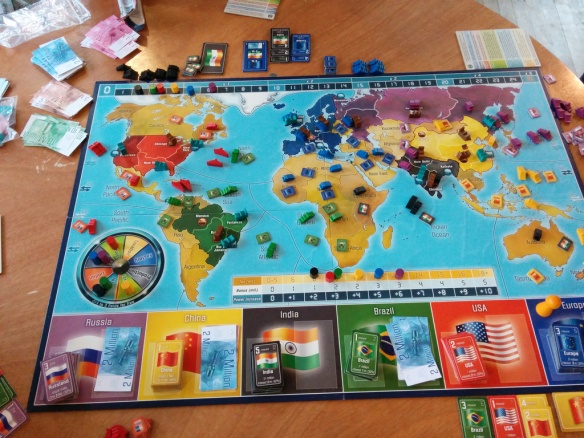
There are six nations on the board, they have factories that build armies and navies, and little armies and navies march around the world colonizing shit and fighting each other, right? But you don’t play the nations. No no no. You play the evil bankers buying bonds and controlling the fates of nations for your own personal profit. Perhaps you mostly control the fate of Germany. Is England about to attack you? Perhaps you should let the banker who mostly owns England get a little easy stock in Germany. Now you are co-invested. Now you are partners. Now you are safe. Unless they decide to do a sudden hostile takeover of Germany to suicide it into Russia. Oh dear. Now you are not safe. Now the world is in chaos and burning, and everybody is shifting their investment portfolios, and perhaps you need to drain Germany’s bank into your own coffers, to buy some stock in Spain. Spain is starting to look like a nice, stable investment. Oh yes. Spain.
(If you want to do much less intricate, more chilled out and fun world war-mongering, consider the ultra-slick Quartermaster General (M), a team game of World War II, where every country gets it’s own ultra-special deck that lets it act in a completely different way. Germany blitzes! Russia doesn’t need supply lines because it EATS ITS OWN DEAD!)
Race for the Galaxy (M): A Modern Classic. Boils the whole Civilization, building-your-tech-tree and getting-your-economic-engine rolling into one slick, tight, hyper-pleasurable forty minute experience. Plays super fast, constantly forces you to make fascinating trade-off decisions about which direction to take your empire, and then ends the moment before it gets boring. Wildly addictive – I’ve played this thing hundreds and hundreds of times, and I am certainly not alone. It also has this ultra-nifty opportunity-cost mechanic, where the cards in your hand represent both opportunities for new technology, and the resources to build new technologies, so every time you build something you literally have to pay for it by throwing away other opportunities. Delightfully painful. Warning: annoying as hell to learn, but worth it. (Also great as a two-player.)
If you dug RftG, you’ll also probably love that designer’s new game, Res Arcana (M). Res Arcana is a zippy, delightful economic engine game. It resembles a deck-builder, except the game randomly builds a deck for you, and you just have to cope. There are a few things you can buy and adjustments you can make, but mostly, it’s about desperately trying to figure out how to put together an engine from the random pieces you’ve been shove. It’s a perfect couple’s game, too. Once you know it, each game is a slick, fun half-an-hour. But the game really accumulates depth over dozens of plays. A game-loving couple can pound this thing into the ground with hundreds and hundreds of plays. (We have.)
Galaxy Trucker (M): Galaxy Trucker is possibly the most sublimely ridiculous game I have. In Galaxy Trucker, you are a space trucker. You have to build your truck, and then race it. I mean that you have to really BUILD YOUR TRUCK, under time pressure, desperately, out of a pile of tiles that represent all these weirdly shaped parts, none of which will fit quite how you want them to.

All the players build their damn truck simultaneously, desperately grabbing one tile at a time and trying to make the connections fit, and to get the right parts to make your truck go, have life support, have weapons, have batteries, what have you. It’s timed. It’s desperate. You’re all digging through the same set of tiles. Your trucks all suck. The pieces barely hang together and your truck’s off-balance. And then you race them, and they run into asteroids and shit, and whole halves of them fall off into space, and you all laugh, because you’re TRUCKING IN SPACE.
Chicago Express (M): There’s this company, called Winsome. Winsome turns out nothing but train games. Every game has very clean, simple rules, and almost all of them involve trading stocks in some train companies and building track for those companies. Most of them permit this complex dance of co-investing, complex stock portfolios, and incentivizing other players to do what you want by screwing with the market. And all of them involve incredibly intricate, mathematical, emergent play, full of sharp edges and precision and the opportunity to screw or be screwed, to pull off a brilliant subtle manipulation of the entire market, or to have the weight of the world dumped on you by another player.
Chicago Express is probably the best Winsome game that’s readily available. The rules are simple, probably easier than anything else in this section. It plays fast – once you know it, under an hour, easily. The play is rough, precise, and incredibly emergent, as tiny choices have complex butterfly effects down the line.
A lot of modern Eurogames are engineered to be nice and polite to everybody. Even if you don’t understand the game, or are doing poorly, things will be fairly pleasant for you and you can do pretty well. Not Winsome games. In Winsome games, the cliffs are everywhere, you can drive off one with a bad move in your first one, and other players can shove you off the nearest cliff if you’re not careful. If your mind tends towards, say, Chess or Bridge, but you want to be able to manipulate alliances through co-investment, you might love this game.
El Grande (M): One of the great classic Eurogames from an earlier era. Before the modern Eurogame technology made everything easy and safe and gave everybody something interesting to do in a thousand quick little turns, there was this monster. There are only nine goddamn turns in the entire game. The basic board-play is simple: you’re trying to dominate areas with the most pieces to get points. But each turn, the game unveils you five very starkly different possible actions for everybody to consider. Some actions are extremely weak, some are near useless, some let you do one clever thing, some are catastrophically powerful. Everybody stares at the possible actions, and the board state, and try to figure out all the things that could possibly happen. And then you have an auction to decide what order you’re picking your actions. Which is basically the single deepest, coolest, complexest decision I know in any multiplayer boardgames.
Crucially: everybody starts with the same pot of money for this auction, and you don’t ever get any more. So you have to time it right, go cheap when you can make good use of a weak action, and really time your one power-play just right for maximum effect. Profound.
Root: A Game of Woodland Might and Right (M): So Root is the best new game I’ve played in years. It’s a kind of profound political/economic/hearts and mind simulation. Where each side is completely different, and playing by different rules. It’s about the struggle between the Marquise de Cats – a bourgeois industrialist who rules the forest, and who is literally a fat cat. Versus the Eyrie – who are brittle and rule bound warlike old aristocrats. Also they are eagles. Versus the Woodland Alliance, a loose collection of, like, underground (literally!) critters, like squirrels and mice and shit, who are trying to win over the people to their cause and create a fucking revolution. It’s based on the COIN games – a set of massive, ultra-elaborate asymmetrical war-games, built to model wars of counterinsurgency. But all of this boiled down to a simple, clean, easyl-to-learn rule-set, playable in 60-90 minutes.
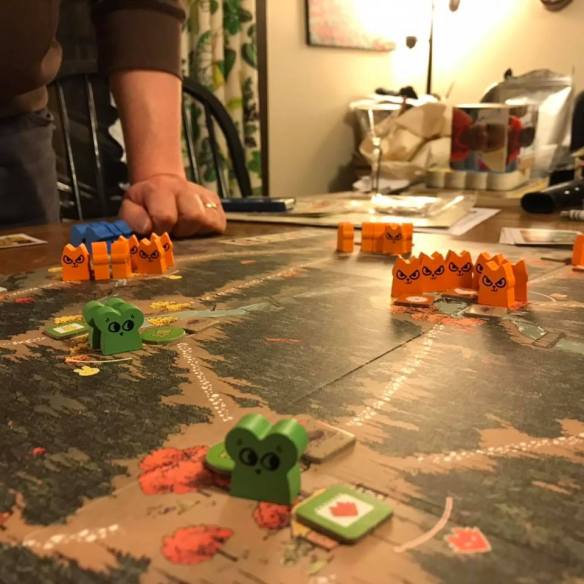
The Marquise de Cats is playing an infrastructure and troop movement game. They build buildings, collect resources, make troops, and brutally suppress any opponents. They’re wealthy and powerful, and they have a ton of troops. They are the status quo, and get a steady stream of easy points. The Eyrie are the brittle warlike old aristocracy. They are playing this weird planning game. They have to program way in advance all their moves. Once they have a plan in place, they get to execute the whole thing every turn. So they get to do a ton of shit for free. And they can keep adding complications to their plan. But they have to execute the whole plan every turn, and they can never simplify it. And if they ever can’t execute one tiny bit of their plan, then they fall into turmoil, their plan falls apart, they lose a ton of points, and they have to start planning from scratch. This simulates a turbulent society with constant regime changes and inflexibly dogmatic regimes and massive leadership instability. The Woodland Alliance starts with no troops or bases on the board. They slowly start building the people’s sympathy, creeping it across the board, while the Marquise and the Eyrie ruthlessly try to use their troops to stamp out that sympathy. But if the Woodland Alliance can get enough resources together, they can create mini-revolutions, which kill all the other players’ troops and create Alliance bases. And then you can pump out warriors who can scamper off to other spots and melt away into the woods and create more sympathy.
Anyway, it’s incredibly tasty. The Marquise just needs to keep things stable to win. The Woodland Alliance is super weak at first, but if they can get enough of sympathy, they can just explode and take over everything – so the other players have to stomp on them constantly to keep them from a foothold. The Eyrie are hysterical – desperately concocting more and more convoluted plans, which are at first super powerful, until they have to start doing insane and nonsensical stuff to match their plan, and then everything falls apart and their leadership collapses. The degree to which the class politics and the nature of counterinsurgency warfare emerges naturally from the system is… amazing. (Interestingly, the COIN games on which this was based have been criticized for baking a hard right wing ideology into their mechanics. But Cole Wehrle, the designer, was a history grad student with a taste for Foucault, and… it shows.)
Two-player games
Star Realms (E): Star Realms is candy. Star Realms is crack. I have played so many hundreds of games of Star Realms that I have worn out my deck and may never be able to play it again. When Melissa was planning to do unmedicated labor for our child, her plan, instead of medication, was just to bring Star Realms to the labor room. And it worked.
OK, backing up. There’s a relatively new family of games called deckbuilders, where you build your deck of special powers cards from a market during the game itself. It all started with Dominion, which other people love, but which I find the gaming equivalent of stale toast. In Dominion, you start with a simple deck of ten boring cards. The game randomizes for you a market of ten very fancy cards with all kinds of weird special powers, and you and your fellow players go shopping for thirty minutes to improve your deck as quickly as possible. You buy cards into your deck, which let you do crazy things to buy even more cards, and onwards and onwards. Lots of room for clever tricks and special-power combinations. Dominion hit big, and now everybody’s making deck-builders. There are ultra-deep deck builders, like the majestic three hour fantasy role-playing deck builder Mage Knight. There’s the ultra-fun quick two-player deck builder Ascension, which introduced the idea of having an ever-changing market of random new special power cards, instead of Dominion’s stable market. And then Star Realms came along and distilled the Ascension formula into a pure, gleeful 20 minute gaming crack.
I’m not saying that Star Realms is the best or deepest deckbuilder, but it is surely the most perfectly addictive. I recently introduced Star Realms, and it’s sequel Hero Realms, to a couple we’re friends with, and they report that basically they spent the last three weeks not leaving the house and just playing round after round of Star Realms and Hero Realms and, like, not really showering. Or sleeping.
If you dig this kind of game, there are tons of deck builders out right now. I have a particular affection for Tyrants of the Underdark and Knizia’s very elegant, simple multiplayer take, The Quest for El Dorado, both of which add spatial boardplay to all that card shopping. The deepest game in the whole deckbuilding space is probably Puzzle Strike, which is a little clunky to learn and a little clunky to play in the physical version. But I played a few hundred games of this on the iOS version, and felt like I was just starting to see the profound depths of the strategic space.
Lost Cities (E): Another elegant Knizia masterpiece. Incredibly simple rules. Read the rules, and it seems like there’s almost nothing there, and no interaction. Play is quick and snappy and easy, and suddenly you realize how much you can subtly screw with the other player. Simple, sweet, clean fun. Very chill and calming. I’ve played this hundreds and hundreds of times. Along the chill fun line, also try Jaipur (E).
Battle Line/Schotten Totten (M): Possibly my favorite Knizia two-player game? Astoundingly elegant game of playing nine simultaneous mini-poker hands at once. A game of brinksmanship, bluffing, and information flow. A dense, fast, but very profound gaming experience, and you can learn it in about four minutes. This one makes my armpits sweat and my adrenaline surge. Amazing.
(PS: Schotten Totten was the original version, and has a kind of stupid theme of Scottish Highland Games. Then they brought it to the US and released it as Battle Line, with a Roman war theme that much better fits the mechanics. But the stupid American publishers demanded Knizia add special powers cards. Fuck the special powers cards. They take an elegant, vicious classic of calculation and turn it into this stupid random chaotic silly thing. They ruin the game. Just play without them.)
YINSH (M): Kris Burm is a genius at spitting out actually genuinely new abstract game ideas. They’re all clever, and some of them are super deep. YINSH is one my favorites – kind of like Othello amped up with flipping pieces and rings jumping around flipping everything and absolute chaos. It’s super-easy to learn the rules, but good game-play is tough, counter-intuitive. Once you figure it out, it will rewire your brain. Other marvelous games from Burm: PUNCT, the brain-melty game of flying, rotating, three-dimension stacking of bridges, and GIPF, a sublime and subtle game of sliding rows and quietly shifting relationships.
Twilight Struggle (H): Years ago, my best friend from college had moved to New York, and I was going out to visit him for five days. We had all these plans to go experience the wonders of the city. But I’d also brought a copy of this new war-game, Twilight Struggle, see. And instead of doing anything useful with our lives, we stayed in his cramped and sweaty apartment and knocked out game after game and game of Twilight Struggle, because it had colonized our brains.
Twilight Struggle models the cold war. Twilight Struggle is Russia and the US subtly manipulating the political infrastructure of the world in a careful tug-of-war, pushing everybody to a state of near war while trying to stay under actual nuclear oblivion. Twilight Struggle is a wargame built around the clever use of cards to do stuff on the board, where each card can do a bunch of different things, and every action involves this endlessly painful set of choices about how and where to use your cards. Twilight Struggle is amazing. It is long and tense and an utterly fabulous, sweat-drenching gaming experience.
Also: if you’e loved Twilight Struggle, seek out Hannibal: Rome vs. Carthage (UH), the earlier game design which inspired Twilight Struggle. Hannibal is harder to learn, harder to play, and takes longer, but is even better. It is maybe the best wargame I’ve ever played – an astoundingly deep experience of fast armies fluidly fencing and dancing around each other, ripping up the terrain for political advantage. And it’s back in print!
Polis: Fight for the Hegemony (H): A slick, slick combination of wargaming and European resource management, where you spend most of your time stomping around with your armies blocking each others trade-routes and choking off each others’ ability to get the necessary resources to build some fucking infrastructure. Part wargame, part Civ-type economic engine builder, but where the two strands are perfectly interwoven. Elegant, subtle, awesome.
Android: Netrunner (H): Also in the running for the Greatest Modern Game Design. Insane, gorgeously thematic, ultra-tense design. One of you is the evil Corporation, trying to take over the world. The other of you is the hacker, trying to break in and expose the corporation. Completely asymmetric play. The Corporation can only build its infrastructure and set its traps. The hacker has to desperately scrounge up money and then break in, taking wild risks. The Corporation player has to be stealthy, full of bluffs, to hide their intent. The hacker has to use their limited resources to scout, to finagle information, has to take massive risks. The mechanics are gorgeously thematic. The hacker can hack anything – they can try to break into the Corporation’s draw deck, hand, discard pile, steal anything. The Corporation can use evil defensive software to deliver brain damage to the hacker, which the game portrays by reducing the hacker’s maximum hand size. Every part of this game is delicious.
This is a constructed deck game, like Magic: the Gathering, but without the worst of the collectible wallet-destroying part. You can actually, if you don’t want to compete at a high level, grab a relatively small and affordable set and play it. Another option, if you want to do the Magic-but-not-collectible thing, is Ashes: Rise of the Phoenixborn (M). It’s quicker to learn and slicker than Magic, with lots of subtlety and flair. There’s a cool dic that give you how much of the various sorts of power you have to spend each turn And also you can just buy the damn box and never buy another thing.
Julius Caesar (H): This is standing in for a whole bunch of Columbia Block Wargames. The world of wargames is full of historically accurate monsters with 40 page rulebooks and fine-grained simulatory madness. The Columbia Block Wargames are usually good at simplifying that down to a manageable level, of leaving in just enough historical grit in the rules to give the play some of that particular texture. And the blocks themselves have an orientation, like Stratego, so a lot of information about troop distribution is hidden.
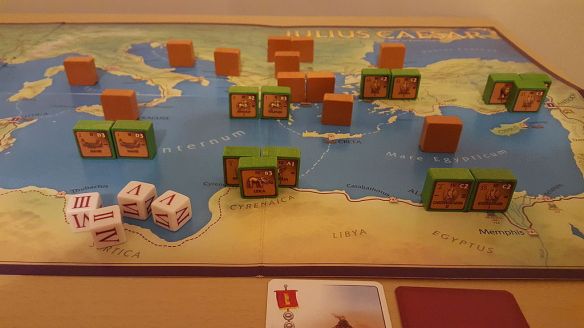
Julius Caesar is a particularly nice place to start. Not many rules, relatively speaking. Lots of mobility and strategic flexibility, lots of feinting and bluffing and head-fakes, and really interesting, strategically specific play. A lot of this game comes down to how many troop movement clogs up the roads differently, and which roads can handle a lot of troops and which can only handle a little, and where mobility choke-points are.
There’s tons more to play after this one, but my favorite of all the Columbia games is Rommel in the Desert (H). It’s significantly more rules than Julius Caesar, but what you get is this fabulous particular game, about tanks that can blitz over the roads but bog down in the desert, about desperate supply lines stretching between oases, and about the fact that there’s never enough fuel to do all the moving you want, and trying to figure out how much fuel your opponent has stockpiled, and it is pure unrelenting tension, broken by explosions of motion.
Sekigahara (H): Sekigahara is maybe the new the creme de la creme –maybe finest development of the whole modern wargames movement. It combines a lot of the mechanics from all the stuff above – the hidden units of the Columbia Block Games, the delicious card-based strategy of Twilight Struggle – into one utterly elegant, crisp, and profoundly playable and deep wargame. It simulates the war of unification in 1600’s Japan. It was a conflicting loyalties, of different commanders trying to gather the various clans to their side, and the whole game is built from the ground up to model that that struggle for lotalty. You get cards at the beginning of every round, and each card bears a clan-marker. You have to spend cards to move troops. But each of your troops comes from a clan. If you get into a fight, you need to have the matching clan card, in order to actually get a given troop unit to fight. So your general might be sitting on a massive pile of troops, but utterly unable to get them to do anything because they don’t trust you. And if you spend all your loyalty in one fight, your opponent knows you’ve used it up, and you can’t call those troops to battle. And if your opponent has the right cards, they can steal your troops from you in the middle of a battle. AND you get extra cards from having your troops die nobly in battle, because that’s… what inspires loyalty? The game is tight, fascinatingly strategic, and absolutely captures the political particularity of that war. And it’s a thrilling, deep nail-biter of a game, full of thoughtfulness, but also moments of bluff-y daring.
Star-Wars: X-Wing Miniatures Game (M): OK, this is the stupidest game that I’m going to recommend. First of all, this is a money trap. It’s got collectible miniatires and there are lots of them and if you’re going to play competitively, or if you’re the kind of person that can get trapped by this kind of capitalist dodge, then you might be screwed. (Though you can have a great damn game with only a few pieces.) Also, the rules are kind of clunky, and also the play is kind of clunky and stop-start-y and you have to keep track of all these stupid data points with these stupid chits that clutter up the play space and it’s just kind of all very ridiculous.
BUT: if you can get through all that, the game itself is… unique, and hysterical, and has its own very special magic. It’s STAR WARS, first of all. One of you is the Rebels, with your choice of X-Wings and B-Wings and maybe even the Millennium Falcon. The other of you is the Imperial forces, with all your TIE Fighters and shit. First, all the pieces move differently. Each ship comes with its own little secret programmable dial, which shows all the moves that particular ship can make. X-Wings are big and heavy and clunky but tough. B-Wings turn on a dime, but they’re slow as hell. TIE Fighters are fast and ultra-maneuverable, but they die like gnats. The Millennium Falcon is massive but ultra-maneuverable, and can do crazy shit like nothing else in the game.
MOST IMPORTANTLY: both sides program all their movements at once, on the secret programmable dials. Then you unveil and unleash. There are these adorable cardboard ruler-type thingies to actually physically move your pieces around the board.

And, after all the clunkiness – where you have to keep track of which pilot is tired, and which ship has a lock on which ship, and where you’re shuffling all these differently shared rulers to move the ships around, and you have to use other stupid ruler to figure out if you’re in range or not – after all that, when the game works, it really goddamn works. It actually genuinely feels like being in a Star Wars dogfight. The pieces zip around, the X-Wings cruise and stalk, the TIE Fighters dodge and weave and roll like crazy fucking insects everywhere. And it’s mental, too. Because you’re programming the ships simultaneously, and it becomes a super-complicated version of The Sicilian Encounter from Princess Bride, where you’re trying to triple-quadruple bluff the other side about where you’re going to go, and sometimes you succeed, and sometimes you fail completely and end up with your ass hanging out helplessly in the face of your enemy’s biggest gun and you get toasted. But when you pull it off – when you take a crazy unexpected turn and barely whiz your Millennium Falcon through like 8 hairpin turns through a tight asteroid field – then, then you feel like a god.
I hear this game goes really deep, and there’s a good competition scene with really high-level play, but basically I only play this game drunk.
(Another goofy and very fun miniatures game is BattleLore (M), which doesn’t have the simultaneous movement thing, but does have this nifty system where cards slightly randomize which part of the battlefield you can send commands to. It’s supposed to simulate the difficulty of command communication. Super fun and very fantasy-nerd.)
“Fuck you, Thi, this isn’t a fucking boardgames, this is torture”
Food Chain Magnate (UH): Absurdly complicated, wild game of building up your own fast food empire. Ridiculously complicated, wildly chaotic emergent play, and utterly fantastic. You need to hire employees to do things. You need to hire middle managers to manage your employees. You need to hire people to make burgers, or pizza, or soda, or lemonade. You need to create advertising on the map to create the demand for your burgers, or pizza, or soda. And then shit goes crazy, because desire is general. That means I can create a massive marketing campaign for burgers, but if my opponent swoops in and cuts the prices on their burgers, then all those burger-mad people will instead go to their shop in droves and I’m shit out of luck. Dense, calculative, wild, thrilling. Also a candidate for the best board game ever. I am not alone in thinking this.
Currently out of print and super-expensive, but worth getting on any waiting lists at Splotter Games for the next reprint, when it happens. More importantly: there’s a cheap iPad version out! If you’re into this kind of thing, there are plenty of other Splotter Games that are also dense, amazing pieces of economic wonderment, especially Indonesia. You usually have to get on a waiting list. They’re expensive, it takes forever, but I have played the hell out of every one I have and loved them all passionately.
1830: Railways and Robber Barons (UH): This is a particularly sterling, and usually findable, example of the most majestic of gaming mega-elephants, the 18xx series. (Another good place to start is 1889, which was specifically made to help people learn this style of game, and it’s a delight.) 18xx is ludicrous, and perhaps, in the end, my actual Favorite Game Experience of All Time. First, there’s a railway game. There are railroad companies, which need to build track, improve their train technology, and operate their trains to make money. Layered on top of that is a stock trading game, where the various players buy and sell stock in those railroad companies. The stock market is wildly mobile and interactive. When companies do well, they pay out dividends and their stock prices surge. When companies do badly, their stock prices drop. When players sell stock, the stock prices drop.
You can manipulate the market. You can trigger a mass sell-off and destroy a company’s stock value. You can manage your company beautifully and steadily chug to the top. You can raid your own company for profit and dump it on somebody else. And the entire stock system creates this complicated system of subtly shifting alliances, as you’re co-invested with other people on the board in a slowly shifting manner – and the alliance structure, you can also manipulate. There’s also this elegant technological obsolescence mechanic, where as higher-tech trains come into play, lower-tech trains stop working, and the whole thing drives the game to this endlessly desperate, manic pace.
If there’s a multiplayer game from the modern era that I think will prove, in the end, to offer the depth of Chess and Go, and still be played hundreds of years from now, I’m betting on 18xx.
This stock mechanic may seem familiar by now. A lot of my other very favorite games – Imperial, Chicago Express – are descended from this one. But this is The Original, the Mothership Connection, and still probably the most intense and thrilling game experience I know. But a warning: it’s complicated. The game takes forever to learn. Playing them takes like six hours, at the very least. There’s math. I mean, I literally hand out cheap scientific calculators to every player at the start of the game, to do various dividend calculations and run possible payoff models. There’s slower sections of the game where everybody is just carefully developing train companies and cautiously watching for possible stock market shenanigans. But everything matters, everything builds towards this climax, and at some point the game kicks into this ludicrous gear, where stocks are flying and portfolios are shifting and the whole game is alive and screaming and insane.
But also: there’s a lot of math.

